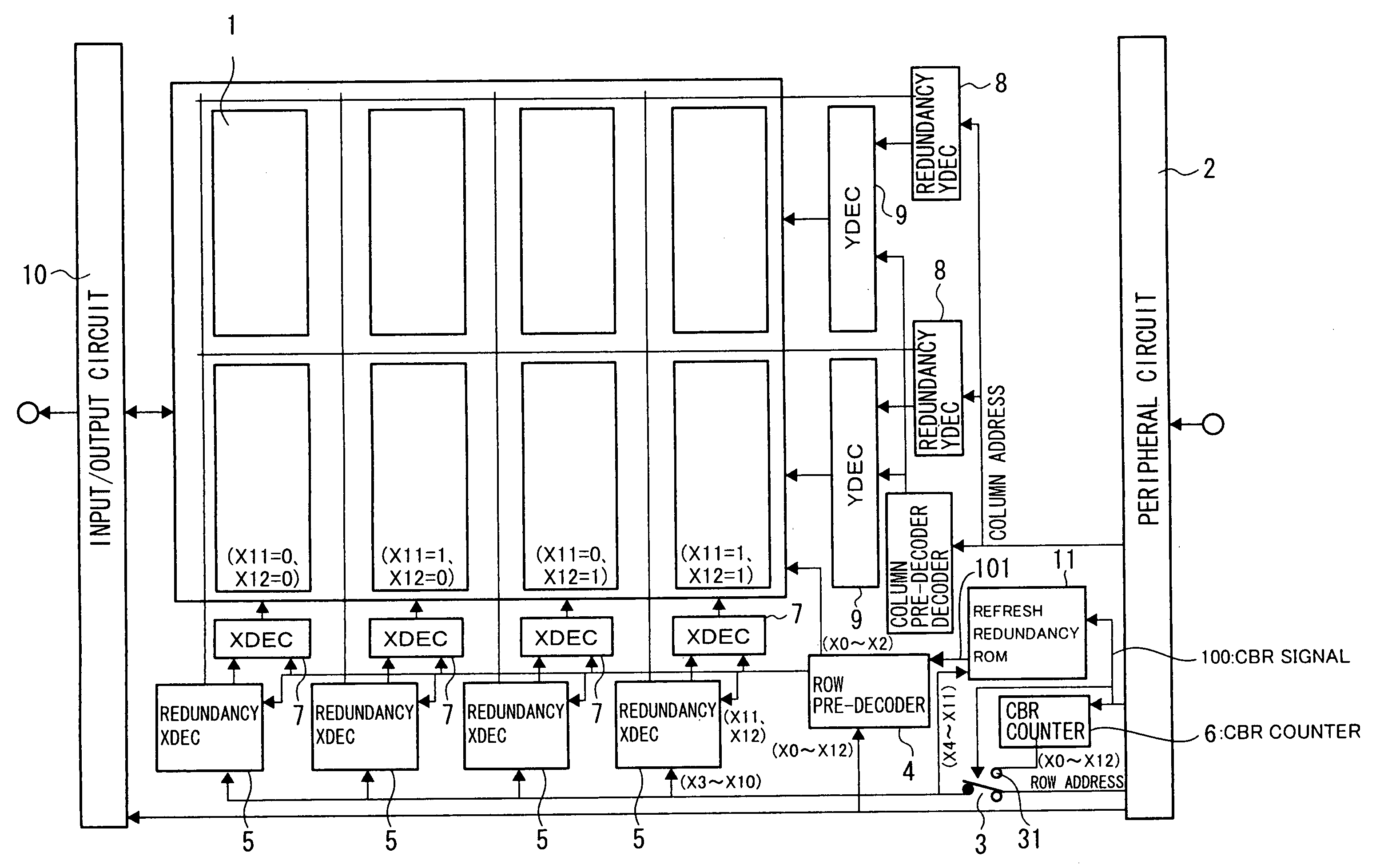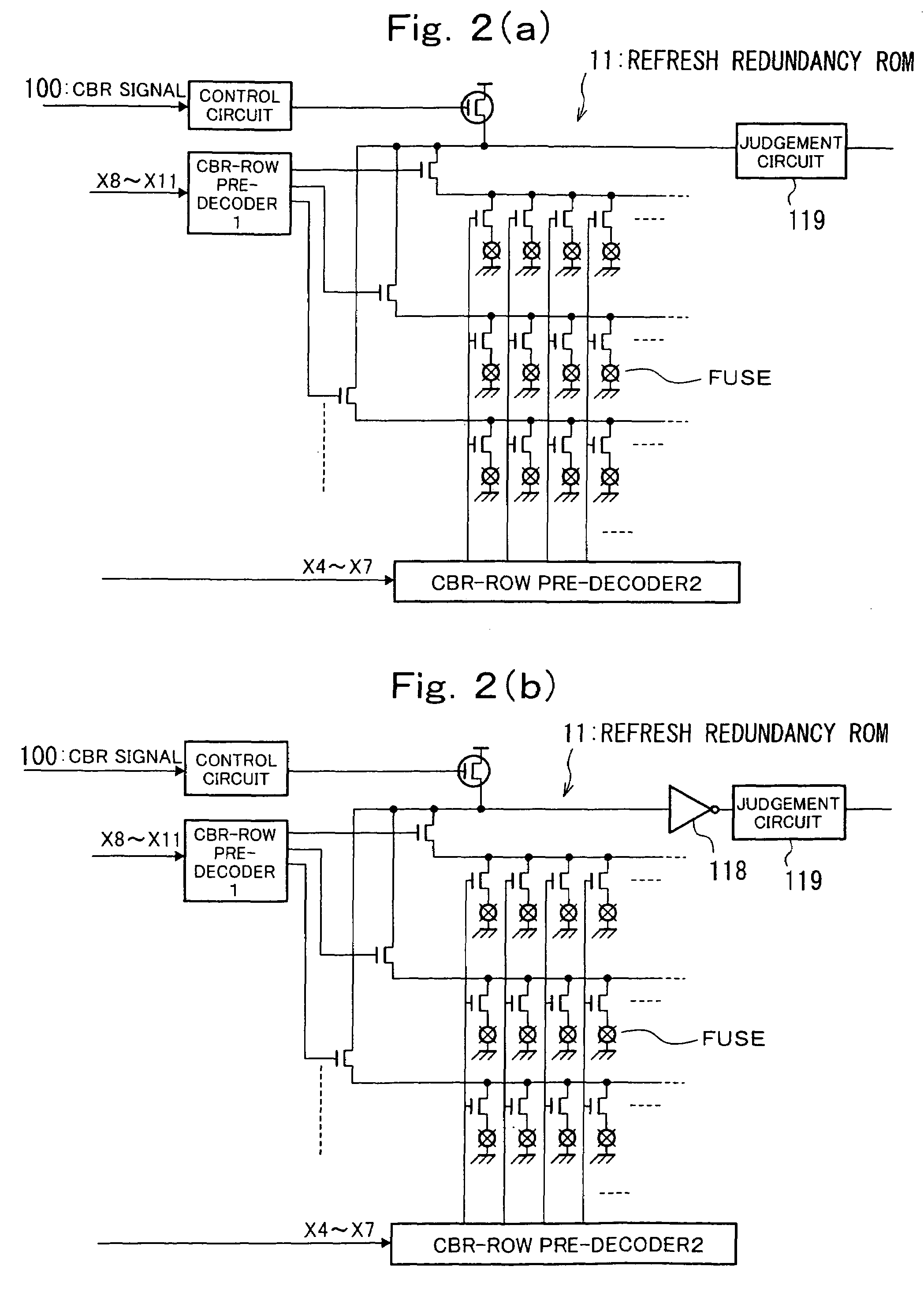Semiconductor memory device and method for manufacturing same
a semiconductor memory and memory device technology, applied in static storage, digital storage, instruments, etc., can solve the problems of increased chip cost, inability to repair this semiconductor memory device,
- Summary
- Abstract
- Description
- Claims
- Application Information
AI Technical Summary
Benefits of technology
Problems solved by technology
Method used
Image
Examples
first embodiment
The First Embodiment
[0048]FIG. 1 to FIG. 3 are drawings showing the first embodiment of the present invention, FIG. 1 being a block diagram showing the configuration of the first embodiment, FIG. 2 being a drawing showing the detailed configuration of the refresh redundancy ROM, and FIG. 3 being a timing diagram showing the operation of the first embodiment.
[0049]The difference between the circuit blocks between FIG. 1 and FIG. 11 is that the first embodiment includes the refresh redundancy ROM 11. Other aspects of the configuration, however, are the same as the past example shown in FIG. 11. Accordingly, the same reference numerals have been applied to corresponding parts, which are not described in detail herein.
[0050]FIG. 2(a) is a drawing showing the configuration of the refresh redundancy ROM 11 in the first embodiment which is formed by MOS switches and fuses arranged in the form of a matrix and a judgment circuit 119, wherein redundancy cell addresses are programmed so that f...
second embodiment
The Second Embodiment
[0059]The second embodiment of the present invention is described below with reference made to FIG. 2, FIG. 4 and FIG. 5, FIG. 4 being a block diagram showing the second embodiment, and FIG. 5 being a timing diagram showing the operation of the second embodiment.
[0060]The second embodiment differs from the first embodiment in that a D-type flip-flop 12 is provided, which latches the output of the refresh redundancy ROM 11.
[0061]In this case, it is also possible to use another type of holding circuit in place of the D-type flip-flop 12, as long as it enables the latching of the output of the refresh redundancy ROM 11.
[0062]In the second embodiment, as shown in FIG. 5, when the CBR signal 203 of the immediately previous REF command 201 is reset, the CBR counter 6 counts up, a refresh redundancy judgment being made in advance at this address and, if there is coincidence, a coincidence pulse 204 is output from the refresh redundancy ROM 11, this data being held in t...
third embodiment
The Third Embodiment
[0069]FIG. 6 is a timing diagram showing the operation of the third embodiment.
[0070]The semiconductor memory device according to the third embodiment provided with a D-type flip-flop 12 that latches the output of the refresh redundancy ROM 11.
[0071]The third embodiment differs from the second embodiment in that the address programmed into the refresh redundancy ROM 11 is the address immediately before the address of the cell which is to be repaired by “refresh repair” of the present invention.
[0072]Specifically, in the case of FIG. 9, since the address of the failed cell is CA5Bh, the programmed address is CA5Ah.
[0073]That is, in the third embodiment, when the REF command 201 is output, a judgment is made as to whether a memory cell at the address corresponding to the next REF command 202 is to be repaired by “refresh repair” and a coincidence signal 204A is latched by the D-type flip-flop 12. In this embodiment, when the REF command 202 for refreshing a cell is...
PUM
 Login to View More
Login to View More Abstract
Description
Claims
Application Information
 Login to View More
Login to View More - R&D
- Intellectual Property
- Life Sciences
- Materials
- Tech Scout
- Unparalleled Data Quality
- Higher Quality Content
- 60% Fewer Hallucinations
Browse by: Latest US Patents, China's latest patents, Technical Efficacy Thesaurus, Application Domain, Technology Topic, Popular Technical Reports.
© 2025 PatSnap. All rights reserved.Legal|Privacy policy|Modern Slavery Act Transparency Statement|Sitemap|About US| Contact US: help@patsnap.com



